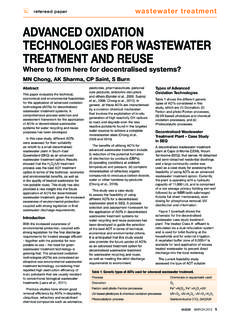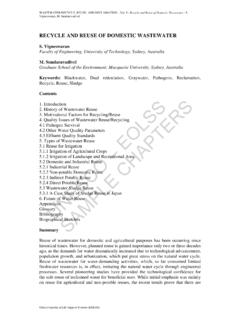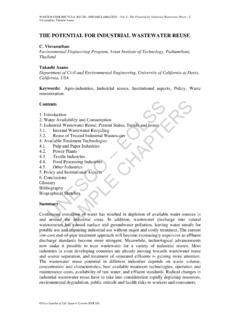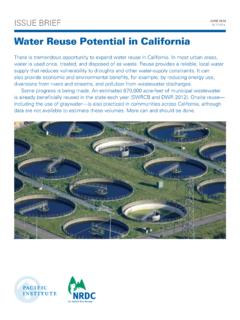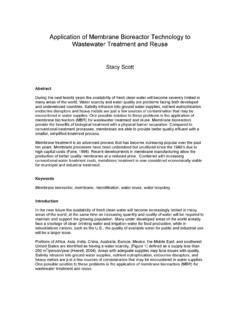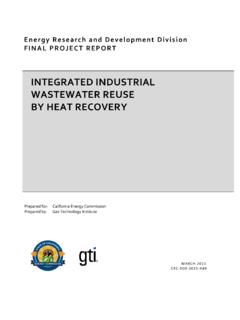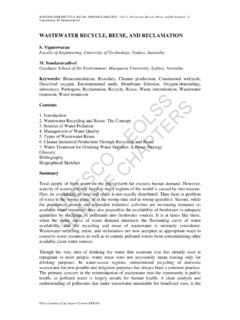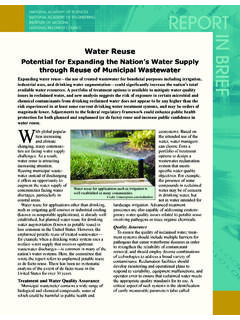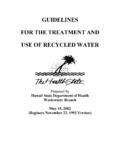Transcription of WATER RECYCLING AND POTABLE REUSE - BAWSCA
1 WATER RECYCLING AND POTABLE REUSE WHITE PAPER Bay Area WATER Supply and Conservation Agency July 2017 Table of Contents i 1. 1 2. 2 a. Common Terms .. 2 3. Regulatory 4 a. Regulation 4 b. Recycled 4 c. SWRCB Order WQ 2016-0068-DDW .. 4 d. Title 22 Division 4, Chapter (Article) 5 4. Advanced 9 a. Indirect and Direct POTABLE 9 i. Indirect POTABLE 9 ii. IPR WATER Quality Requirements, Groundwater 9 iii. IPR WATER Quality Requirements, Surface WATER 11 iv. Direct POTABLE 11 5.
2 BAWSCA Area Wastewater 13 6. BAWSCA Interest in Recycled 17 a. Long Term Reliable WATER Supply Strategy 17 b. Recent BAWSCA Board 17 7. SFPUC Interest in Recycled 18 a. SFPUC 18 8. BAWSCA Efforts Related to Recycled WATER Including 20 a. Current Work 20 i. BAWSCA -SCVWD-SFPUC IPR 20 ii. SVCW POTABLE REUSE Exploratory Plan (PREP).. 20 9. Bay Area Regional Reliability (BARR).. 22 10. BAWSCA Member Agency Efforts in Recycled WATER 25 a. 27 b. Daly 27 Table of Contents (Continued) ii c.
3 27 d. 28 e. 28 f. Mountain 29 g. North Coast 29 h. Palo 30 i. Redwood 31 j. San 32 k. Santa 33 l. Stanford 33 m. 34 11. BAWSCA Strategy Moving Forward for Recycled WATER .. 36 List of Figures: Figure 1 - POTABLE and Non- POTABLE Recycled WATER .. 3 Figure 2 - Groundwater Replenishment and 10 Figure 3 - Surface WATER Augmentation and 11 Figure 4 - Raw WATER 12 Figure 5 - Treated WATER 12 Figure 6 - Wastewater Treatment Plants within the BAWSCA Service 16 Figure 7 - ACWD-SFPUC IPR Project (BARR).
4 23 Figure 8 - BAWSCA Agencies with Active Recycled WATER 26 List of Tables: Table 1 - Allowable Uses of Recycled WATER .. 6 Table 2 - Wastewater Treatment Plants in the BAWSCA Service 13 Table 3 - SFPUC s WaterMAP Prioritized 18 Table of Contents (Continued) iii Table 4 - BAWSCA Member with Active Recycled WATER 25 Attachments: Attachment A - Glossary Attachment B - MOU Excerpts for IPR Feasibility Studies 1 Introduction BAWSCA s Board and member agencies have an ongoing interest in supplemental WATER supply opportunities, including those regarding recycled WATER .
5 Additional documentation on this topic was desired. This white paper was prepared to detail the work being done on recycled WATER by BAWSCA and its member agencies. California WATER agencies, including several BAWSCA member agencies, produce recycled WATER and rely on it as a component of their overall WATER supply. Moreover, advanced purified WATER projects, aimed at producing POTABLE (drinking) WATER are in the planning stage throughout the BAWSCA service area. The amount of WATER RECYCLING , for both POTABLE and nonpotable uses, is expected to greatly expand in the coming years.
6 WATER RECYCLING , also known as WATER reclamation or REUSE , is a reliable, economically feasible and environmentally sensitive means to expand California's available WATER resources and reduce the demand on freshwater systems. Recycled WATER can be safely used to irrigate landscape, golf courses, crops and freeway medians; replenish groundwater basins; flush toilets; and when injected into coastal groundwater basins, act as a barrier to seawater Recycled WATER is also increasingly being used by industry in cooling processes, new home construction, dust control, and for other purposes.
7 The California Department of WATER Resources notes that over 525,000 acre feet of wastewater is recycled each year, with about half of that volume (48%) used for agricultural irrigation. Another 20% is used for landscape irrigation, and about 12% for groundwater recharge. In future years, experts predict California will recycle even more wastewater. The state has set a target of achieving close to 1 million acre feet of recycled wastewater in coming decades. That level of RECYCLING will help toward meeting the needs of California s growing In its 2016 update to the Municipal Recycled WATER Resources Management Strategy, the State includes the following introductory comment California is increasing its integration of municipal recycled WATER into its WATER supply portfolio.
8 In some regions of the state, recycled WATER meets approximately 7 percent of WATER supply recycled WATER benefits the state and individual WATER users by reducing long distance WATER conveyance needs, providing local WATER supplies, and being a drought resistant resource. 3 Although one can point to a continued growth of WATER RECYCLING throughout California, there are concerns that arise when discussing recycled WATER opportunities, including: Public acceptance The recent drought in California has led to a broader acceptance of recycled WATER opportunities and uses.
9 As noted in the media, as the drought has taken hold in California, opposition to the idea (of recycled WATER ) has been drying up, and recycled WATER is winning acceptance. 4 However, there are still significant public hurdles associated with the toilet to tap concept of using highly treated wastewater as a source of POTABLE supply. Cost While cost is just one issue to consider, and technologies continue to improve and treatment capabilities expand, it must be noted that recycled WATER projects are expensive to build and operate, due in no small part to the fact that they are energy intensive.
10 As work on recycled WATER continues, both statewide and within the BAWSCA service area, BAWSCA is well positioned to take an active role in helping to promote its use and to help address the concerns that may arise. 1 WateReuse studies on these topics can be found at 2 As referenced in the 2013 California WATER Plan, available at 3 4 2 Terminology This section presents a subset of the terms used in this white paper. A more complete glossary of terms commonly used in discussions regarding recycled WATER is provided in Attachment A.
